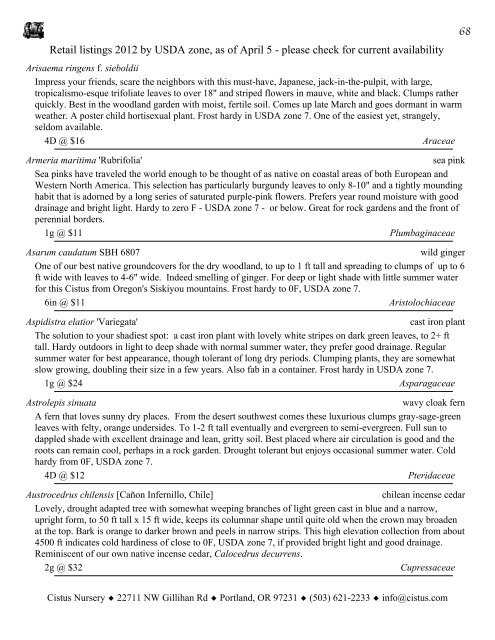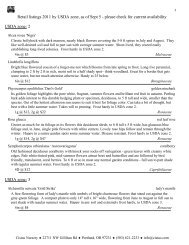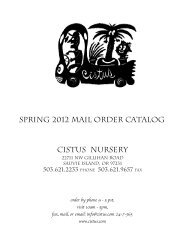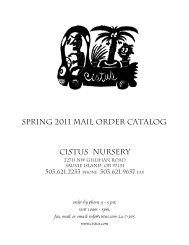1 Retail listings 2012 by USDA zone, as of April 5 ... - Cistus Nursery
1 Retail listings 2012 by USDA zone, as of April 5 ... - Cistus Nursery
1 Retail listings 2012 by USDA zone, as of April 5 ... - Cistus Nursery
Create successful ePaper yourself
Turn your PDF publications into a flip-book with our unique Google optimized e-Paper software.
<strong>Retail</strong> <strong>listings</strong> <strong>2012</strong> <strong>by</strong> <strong>USDA</strong> <strong>zone</strong>, <strong>as</strong> <strong>of</strong> <strong>April</strong> 5 - ple<strong>as</strong>e check for current availability<br />
Arisaema ringens f. sieboldii<br />
Impress your friends, scare the neighbors with this must-have, Japanese, jack-in-the-pulpit, with large,<br />
tropicalismo-esque trifoliate leaves to over 18" and striped flowers in mauve, white and black. Clumps rather<br />
quickly. Best in the woodland garden with moist, fertile soil. Comes up late March and goes dormant in warm<br />
weather. A poster child hortisexual plant. Frost hardy in <strong>USDA</strong> <strong>zone</strong> 7. One <strong>of</strong> the e<strong>as</strong>iest yet, strangely,<br />
seldom available.<br />
4D @ $16 Araceae<br />
Armeria maritima 'Rubrifolia' sea pink<br />
Sea pinks have traveled the world enough to be thought <strong>of</strong> <strong>as</strong> native on co<strong>as</strong>tal are<strong>as</strong> <strong>of</strong> both European and<br />
Western North America. This selection h<strong>as</strong> particularly burgundy leaves to only 8-10" and a tightly mounding<br />
habit that is adorned <strong>by</strong> a long series <strong>of</strong> saturated purple-pink flowers. Prefers year round moisture with good<br />
drainage and bright light. Hardy to zero F - <strong>USDA</strong> <strong>zone</strong> 7 - or below. Great for rock gardens and the front <strong>of</strong><br />
perennial borders.<br />
1g @ $11 Plumbaginaceae<br />
Asarum caudatum SBH 6807 wild ginger<br />
One <strong>of</strong> our best native groundcovers for the dry woodland, to up to 1 ft tall and spreading to clumps <strong>of</strong> up to 6<br />
ft wide with leaves to 4-6" wide. Indeed smelling <strong>of</strong> ginger. For deep or light shade with little summer water<br />
for this <strong>Cistus</strong> from Oregon's Siskiyou mountains. Frost hardy to 0F, <strong>USDA</strong> <strong>zone</strong> 7.<br />
6in @ $11 Aristolochiaceae<br />
Aspidistra elatior 'Variegata' c<strong>as</strong>t iron plant<br />
The solution to your shadiest spot: a c<strong>as</strong>t iron plant with lovely white stripes on dark green leaves, to 2+ ft<br />
tall. Hardy outdoors in light to deep shade with normal summer water, they prefer good drainage. Regular<br />
summer water for best appearance, though tolerant <strong>of</strong> long dry periods. Clumping plants, they are somewhat<br />
slow growing, doubling their size in a few years. Also fab in a container. Frost hardy in <strong>USDA</strong> <strong>zone</strong> 7.<br />
1g @ $24 Asparagaceae<br />
Astrolepis sinuata wavy cloak fern<br />
A fern that loves sunny dry places. From the desert southwest comes these luxurious clumps gray-sage-green<br />
leaves with felty, orange undersides. To 1-2 ft tall eventually and evergreen to semi-evergreen. Full sun to<br />
dappled shade with excellent drainage and lean, gritty soil. Best placed where air circulation is good and the<br />
roots can remain cool, perhaps in a rock garden. Drought tolerant but enjoys occ<strong>as</strong>ional summer water. Cold<br />
hardy from 0F, <strong>USDA</strong> <strong>zone</strong> 7.<br />
4D @ $12 Pteridaceae<br />
Austrocedrus chilensis [Cañon Infernillo, Chile] chilean incense cedar<br />
Lovely, drought adapted tree with somewhat weeping branches <strong>of</strong> light green c<strong>as</strong>t in blue and a narrow,<br />
upright form, to 50 ft tall x 15 ft wide, keeps its columnar shape until quite old when the crown may broaden<br />
at the top. Bark is orange to darker brown and peels in narrow strips. This high elevation collection from about<br />
4500 ft indicates cold hardiness <strong>of</strong> close to 0F, <strong>USDA</strong> <strong>zone</strong> 7, if provided bright light and good drainage.<br />
Reminiscent <strong>of</strong> our own native incense cedar, Calocedrus decurrens.<br />
2g @ $32 Cupressaceae<br />
<strong>Cistus</strong> <strong>Nursery</strong> ◆ 22711 NW Gillihan Rd ◆ Portland, OR 97231 ◆ (503) 621-2233 ◆ info@cistus.com<br />
68







